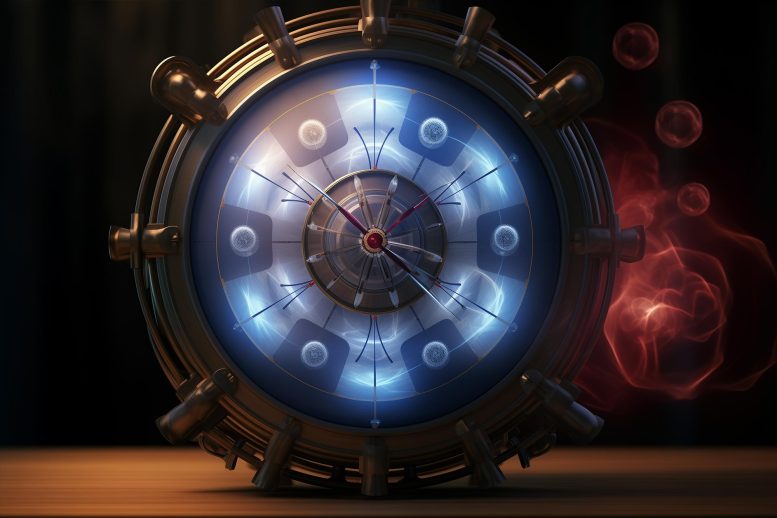
A collaborative research effort has brought the world closer to creating a nuclear clock by precisely exciting scandium-45 with X-ray pulses. This marks a significant leap in timekeeping technology, with the potential for far-reaching impacts in science and industry
Distinguished Professor Dr. Olga Kocharovskaya of Texas A&M and fellow physicists have started the countdown on developing a new generation of timepieces capable of shattering records by providing accuracy of up to one second in 300 billion years, or about 22 times the age of the universe.
An international research team involving Dr. Olga Kocharovskaya, a distinguished professor in the Department of Physics and Astronomy at Texas A&M University, has taken a major step toward development of a new generation of atomic clocks with mind-blowing potential affecting fundamental science and various industries, from nuclear physics to satellite navigation and telecommunications.
Pioneering Research on Scandium-45 Nuclear Isomer
The team’s work, led by Argonne National Laboratory senior physicist Dr. Yuri Shvyd’ko, for the first time resonantly excited the scandium-45 nuclear isomer with the world’s brightest X-ray pulses at the European XFEl (EuXFEL) X-ray laser facility and determined the position of this nuclear resonance with unprecedented accuracy. Their findings are reported in the journal Nature, both online and in the October 19 print edition.
The Potential of Atomic and Nuclear Clocks
“Atomic clocks, such as the cesium-133 clock or the strontium-87 clock, rely on oscillations of electrons in an atom, which can oscillate at highly reliable frequencies when excited by microwave or optical radiation,” explained Kocharovskaya, principal investigator of the National Science Foundation (NSF) project that initiated and supported this research.
Scandium, an element used in aerospace components and sports equipment, enables an accuracy of one second in 300 billion years, or roughly a thousand times more precision than the current standard atomic clock. The combination of scandium-45 and ultra-bright X-ray pulses brings scientists a decisive step closer to the creation of the first-ever nuclear clock that could harness the oscillation of the atomic nucleus rather than its electron shell.
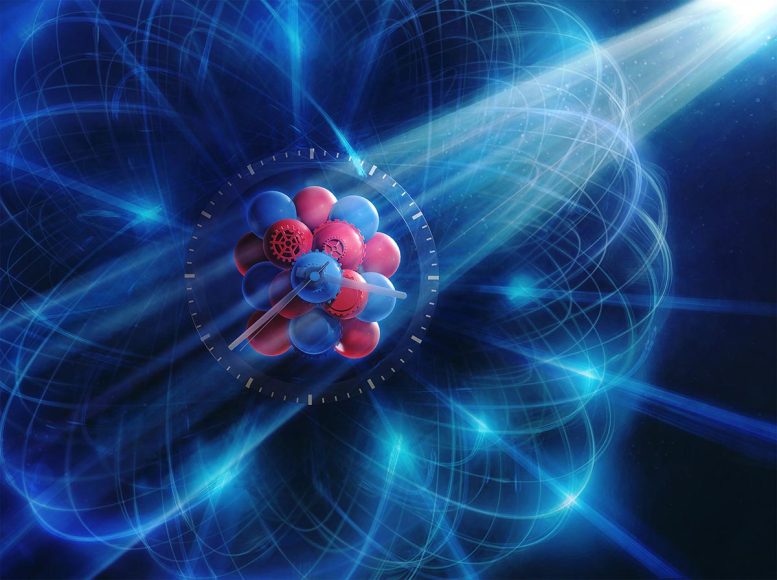
An artist’s rendition of the scandium nuclear clock. Scientists used the X-ray pulses at the European XFEL to excite in the atomic nucleus of scandium — the sort of processes that can generate a clock signal at an unprecedented precision of one second in 300 billion years. Credit: European XFEL/Helmholtz Institute Jena, Tobias Wüstefeld/Ralf Röhlsberger
“For purposes that demand such precision, including the study of certain aspects of relativity, gravitational theory, and other physical phenomena such as dark matter, the nuclear clock is the ultimate timepiece,” said Dr. Xiwen Zhang, a postdoctoral researcher in Kocharovskaya’s group who co-authored the paper.
Revolutionizing Precision Timekeeping
With their accuracy of up to one part in 10,000,000,000,000,000,000, Texas A&M physicist Dr. Grigory V. Rogachev notes that nuclear clocks could usher in a new era of precision timekeeping and enable transformative applications in myriad areas, resulting in a host of applications and advances.
”Humanity has been on the lookout for the technology to make the most precise clocks since the dawn of the modern ages,” said Rogachev, head of Texas A&M Physics and Astronomy and a member of the Texas A&M Cyclotron Institute.
“At present, atomic clocks are the best. Dr. Kocharovskaya and her collaborators are now making the first step toward a new, breakthrough technology. Her research opens a new pathway to utilize the unique properties of the scandium-45 isotope to create the most precise clock ever — the nuclear clock. This advancement may have exciting applications in extreme metrology, ultra-high spectroscopy, and potentially numerous other fields.”
Advancing Quantum Optics and the Role of Collaborative Research
Kocharavskaya’s research interests during the past decade have been focused on extending the field of traditional quantum optics — which she describes as dealing with controllable resonant interactions between optical photons and atomic transitions — into the emerging field of nuclear/x-ray quantum optics focused on control of resonant interaction between x-ray photons and nuclear transitions. In the process, she identified scandium-45 with its long-lived first-excited energy state as the superior candidate both for quantum nuclear storage and the nuclear clock. The main question, she says, was whether it was feasible to reach this state with available x-ray sources.
Together with Shvyd’ko, who had envisioned the high potential of scandium-45 for super-resolution-coherent-forward nuclear spectroscopy along with a possibility of its resonant excitation by X-rays from an emerging new generation of accelerator-based facilities 30 years ago, Kocharovskaya wrote a proposal to the NSF aimed at resonant excitation of a scandium-45 nuclear isomer using X-ray pulses.
“Initially it received mixed reviews, as it was considered a high-risk/high payoff project, but eventually, it was funded, allowing us to plan the experiment at EuXFEL,” said Kocharovskaya, a member of the Texas A&M Institute for Quantum Science and Engineering.
Kocharovskaya credits Shvyd’ko as not only the leader of the group’s research but also an inspiration for the entire team. From coordinating the efforts of all the groups entering every detail of the project to running weekly Zoom meetings discussing the multiple challenges and progress in preparation for the experiment, she says his leadership and hard work provided a tangible example of precisely what it means to see a long-term scientific dream become a reality. In addition, she notes that the project would not be successful without the major contributions of their German colleagues: Dr. Ralf Röhlsberger at DESY and the Helmholtz Institute, Jena; Dr. Jörg Evers at the Max Planck Institute for Nuclear Physics, Heidelberg; and Drs. Anders Madsen and Gianlcuca Geloni at EuXFEL, along with the groups they each lead.
Future Directions and Challenges
“As soon as the resonance was seen within the first several hours of the data collection, we all joyfully celebrated this success,” she added. “It was rewarding for all of us, but especially for Yuri, who realized a high scientific potential of scandium-45 for super-resolution nuclear spectroscopy and the possibility to excite it with modern accelerator-based X-ray sources 33 years ago.”
Never one to rest on their laurels, the team already is focused on the next steps and goals, starting with determining the resonant transition energy with even higher accuracy and measuring the exact lifetime of an isomer state. In addition, there’s also observation of the coherent forward nuclear scattering and measuring the linewidth of the nuclear transition.
“The next two steps can be achieved in a relatively simple way,” Zhang acknowledged. “While the third step is extremely challenging, it’s absolutely critical in order to estimate a projected accuracy and stability of any future nuclear clock. As a group and as a broader research team, we all look forward to the challenge.”
For more on this breakthrough, see Breakthrough for Next Generation Atomic Clocks.
Reference: “Resonant X-ray excitation of the nuclear clock isomer 45Sc” by Yuri Shvyd’ko, Ralf Röhlsberger, Olga Kocharovskaya, Jörg Evers, Gianluca Aldo Geloni, Peifan Liu, Deming Shu, Antonino Miceli, Brandon Stone, Willi Hippler, Berit Marx-Glowna, Ingo Uschmann, Robert Loetzsch, Olaf Leupold, Hans-Christian Wille, Ilya Sergeev, Miriam Gerharz, Xiwen Zhang, Christian Grech, Marc Guetg, Vitali Kocharyan, Naresh Kujala, Shan Liu, Weilun Qin, Alexey Zozulya, Jörg Hallmann, Ulrike Boesenberg, Wonhyuk Jo, Johannes Möller, Angel Rodriguez-Fernandez, Mohamed Youssef, Anders Madsen and Tomasz Kolodziej, 27 September 2023, Nature.
DOI: 10.1038/s41586-023-06491-w

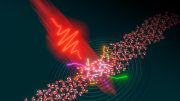

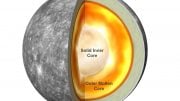


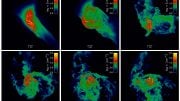

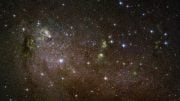
You have indeed achieved some results. However, how do you determine that the nuclear clock is the ultimate timepiece.
According to the theory of topological vortex gravitational field, the world is an interconnected whole. Every object has its own phase field. The world maintains the state of each object in space and time through the interaction and balance of these phase fields.